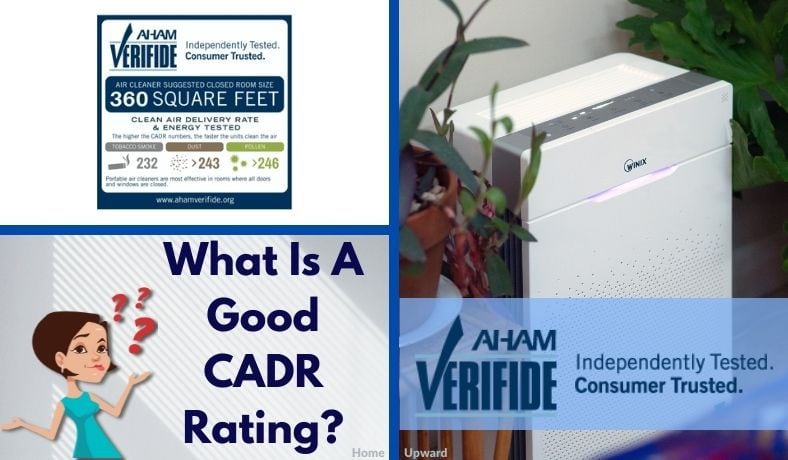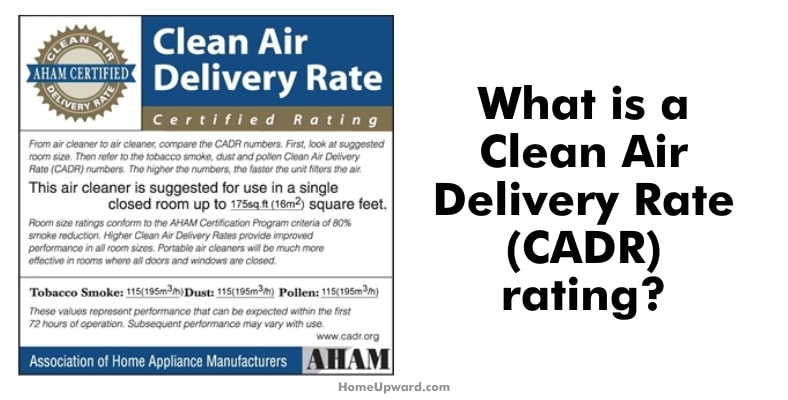When it comes to measuring air purity, there is no higher standard than the Clean Air Delivery Rate, or CADR. But what is a good CADR rating? And what does it take to get a good CADR rating?
Let’s dig in and find out more!
Contents
What is a Clean Air Delivery Rate (CADR) rating?
CADR is a way of measuring how well an air purifier is performing at cleansing the air.
The Association of Home Appliance Manufacturers (AHAM) created and maintains the industry standards for CADR ratings. The AHAM randomly selects products that are classified or classify themselves as air purifiers. The independent tests aim to confirm whether the appliance meets the performance levels recommended for consumers.
Air purifiers are rated based on their being able to clean particles from the air in cubic feet per minute, or CFM.
There are three main types of pollutants and particles that the CADR measures. They are pollen, smoke, and dust. Smoke represents small particles, pollen represents medium, and dust represents large-sized particles that an air purifier should clean from the air.
In the U.S., CADR is measured in cubic feet per minute (CFM). A CADR rating will be in CMM, or meters per hour in most of Europe and Asia.
Very basically, a CADR rating lets you know how much clean air the air purifier produces. The great news is that a high CADR rating does not mean the purifier uses a lot of energy.
How is CADR calculated?
CADR measures how well an air purifier moves airflow in CFM, multiplied by how efficient the air filter is.
An air purifier that runs at 200 CFM with a 100% filter efficiency rate would receive a CADR score of 200.
If that same air purifier runs at 200 CFM, but with only a 75% efficiency rate, the CADR would be 150.
Do all purifiers sold have a CADR rating?
Not all air purifiers will come with a CADR rating.
The Association of Home Appliance Manufacturers (AHAM) randomly selects air purifiers. No company can pay to receive a good AHAM rating. While this is a great way to maintain the CADR rating value, it also means that not every single appliance will have one.
While some manufacturers will volunteer to have their air purifiers tested, many others will not, as it is not required to produce or market the cleaner to consumers.
Just because an air purifier does not have a CADR rating does not mean it is not a suitable appliance. However, because a unit has a CADR rating, it doesn’t mean it’s a good purifier!
Smoke, pollen, and dust CADR scores
CADR scores are composed of three main areas: smoke, dust, and pollen. These measurements show how many microns the air purifiers remove from the air. A micron is also known to 1-millionth of a meter (or a micrometer.)
Smoke CADR scores
Particles that are in smoke are considered the smallest particles an air purifier will remove from the air. These particles are considered very fine and will fall in a range of .1 to .3 microns.
Dust CADR scores
Particles that fall into the dust category are the most common particles filtered out by air purifiers. Particles will have a size of .5 to 3 microns.
Pollen CADR scores
Particles in the pollen category are the largest particles – you can see these with the naked eye! These large particles will fall into a 5 to 11-micron range.
How CADR ratings are helpful
CADR ratings are helpful because it gives you a reliable, individually tested score on the air purifier’s performance.
A CADR rating is also a good measurement of the strength of the unit. You can use CADR to know whether the purifier will be strong enough to clean the room thoroughly.
Benefits of a high CADR score
Because a CADR rating measures how many particles an air purifier is removing from the air, it can also benefit consumers.
When you want to compare air purifiers, you can use the CADR rating to measure the airflow and how efficient the filter is.
In our earlier example, we compared how an air purifier with a 75% filter efficiency will have a lower CADR score than one with the same CFM but a 100% filter efficiency rate.
A CADR rating will help you cut through clever, misleading marketing messaging or shiny advertising tricks and see how well an air purifier actually performs.
For example, a manufacturer may boast on how high their particle count is, using marketing messaging that can mislead you to believe that their air purifier is more efficient than anyone else’s. As the consumer, you may see a high particle count and assume that this means the air purifier is the best. However, the CADR rating could be low, meaning that it does not have a good airflow or efficient air filter while it may remove particles.
What is a good CADR rating?
CADR is not always a flat score, which means that you might have to do a little math to decide if the air purifier has a good enough CADR rating for your room size.
The AHAM has a simple formula to determine the CADR range your purifier should have. Take the CADR score, and multiply it by 1.55. Or, if you know what the square footage of your room is, divide it by 1.55 to find the CADR rating that is best for your space.
For example, a 155 sq ft room will need an air purifier that has a CADR score of 100.
How do they test for CADR?
The AHAM will randomly select an air purifier to test. A manufacturer can not pay to be on the list, nor can they pay to receive a good score.
The testing professional will put the purifier on the highest setting. The purifier will get a brand new filter that the manufacturer says fits the appliance.
The CADR review professional will then run the air purifier and calculate the CADR rating. They will then compare the purifier’s advertised settings vs. how well it performed.
What are the drawbacks of CADR ratings?
There are a few disadvantages to measuring how well an air purifier will perform when measuring by CADR rating only.
Because air purifiers are measured on the highest setting, it will not reflect how much the filter purifies on any other setting. Unless you are running your appliance on high, you might not notice as much purification as running on high.
If you react to noise levels, then don’t use a CADR rating as your only decision-maker. The CADR rating doesn’t measure or include noise rating in its score.
A CADR rating doesn’t measure motor reliability, overall energy usage, or ozone production.
Additionally, HEPA (High-Efficiency Particulate Air) filters and true HEPA filters may receive lower CADR ratings, even though they remove more air particles than regular purifiers.
CADR ratings and air filters
Another drawback of CADR ratings is concerning the actual filters used during the rating system.
An air purifier is always tested on high, with a brand-new filter. The CADR rating will not reflect how the purifier will perform over time as it collects particles and removes pollutants from the air.
A fragile filter that comes with a purifier may perform very well during the CADR test but will not stand up over time. It will begin to reduce in performance very much.
The best way to combat this drop in how air is purified is to look at the actual filter media count. Filters with higher amounts of filter media will perform at much higher rates for a much longer period of time than small, thin filters.
What is a HEPA filter?
The Government developed the first HEPA filter in the 1940s during WWII.
It was created when the military was designing gas masks that would be the most effective in protecting troops from mustard and other airborne gas.
HEPA (or high-efficiency particulate air) filters are made from glass or synthetic materials to form a mat of arranged fibers. These fibers are randomly aligned – this helps to ensure they capture particles of different sizes.
Technically, a HEPA filter should filter out 99.97% of particles. In Europe, that rate is 99.95%.
Filters that score between 85% – 99.95% are considered EPA, or efficient particulate air. ULPA filters must have a 99.999% rating.
True HEPA filters explained.
If you see the term “true HEPA” filter, it refers to the American standard rather than the European standard.
To be considered a HEPA filter in the US, a filter needs to have a 99.97% particle rating. European filters can be rated HEPA but not meet that 99.97% rating.
A note on choosing air purifiers & room size
While having a high CADR score and true HEPA filter rating is important, that is only part of the puzzle.
You should also think of the size of the room the air purifier will be cleaning. An overpowered purifier may create low air quality in a space too small for the unit.
Conversely, a small air purifier may not clean the air of a huge room well enough. Ensure that you are using a unit with an appropriate purification rating for your room’s square footage.
Top things to consider in air purifiers
When it comes to picking the right air purifier for you, there are a few measurements and points of interest we suggest you consider.
- CADR rating
- Decibel level (or noise rating)
- Filters (the amount of filter media, size of the filter, and overall efficiency)
- The safety features, such as tech that could introduce things that can pollute your air or produce ozone
- The motor’s quality







